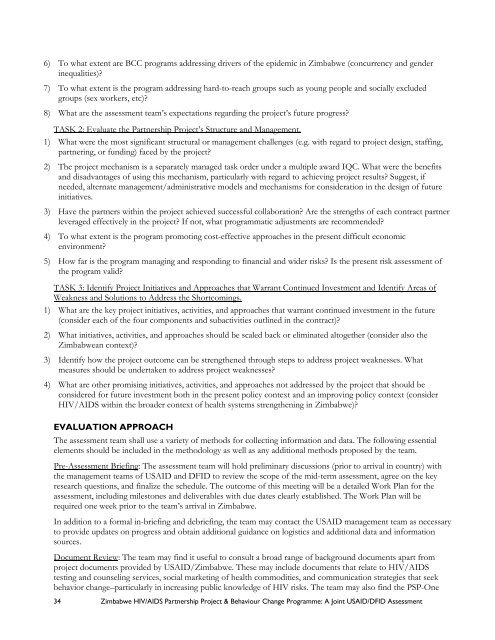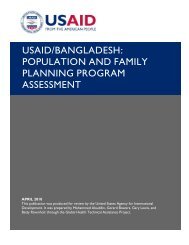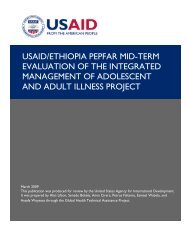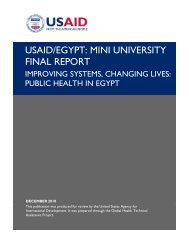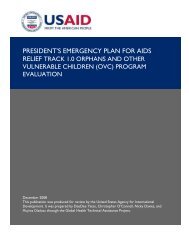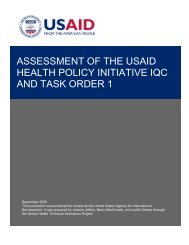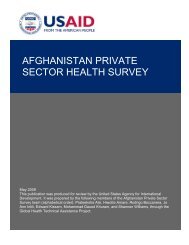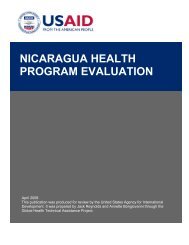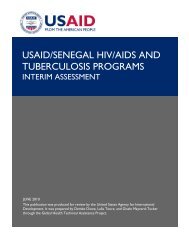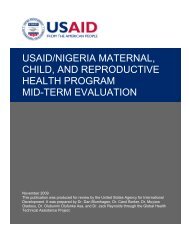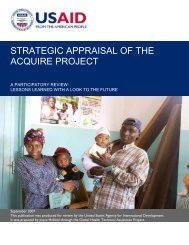Zimbabwe HIV/AIDS Partnership Project & Behaviour Change
Zimbabwe HIV/AIDS Partnership Project & Behaviour Change
Zimbabwe HIV/AIDS Partnership Project & Behaviour Change
- No tags were found...
You also want an ePaper? Increase the reach of your titles
YUMPU automatically turns print PDFs into web optimized ePapers that Google loves.
6) To what extent are BCC programs addressing drivers of the epidemic in <strong>Zimbabwe</strong> (concurrency and genderinequalities)?7) To what extent is the program addressing hard-to-reach groups such as young people and socially excludedgroups (sex workers, etc)?8) What are the assessment team’s expectations regarding the project’s future progress?TASK 2: Evaluate the <strong>Partnership</strong> <strong>Project</strong>’s Structure and Management.1) What were the most significant structural or management challenges (e.g. with regard to project design, staffing,partnering, or funding) faced by the project?2) The project mechanism is a separately managed task order under a multiple award IQC. What were the benefitsand disadvantages of using this mechanism, particularly with regard to achieving project results? Suggest, ifneeded, alternate management/administrative models and mechanisms for consideration in the design of futureinitiatives.3) Have the partners within the project achieved successful collaboration? Are the strengths of each contract partnerleveraged effectively in the project? If not, what programmatic adjustments are recommended?4) To what extent is the program promoting cost-effective approaches in the present difficult economicenvironment?5) How far is the program managing and responding to financial and wider risks? Is the present risk assessment ofthe program valid?TASK 3: Identify <strong>Project</strong> Initiatives and Approaches that Warrant Continued Investment and Identify Areas ofWeakness and Solutions to Address the Shortcomings.1) What are the key project initiatives, activities, and approaches that warrant continued investment in the future(consider each of the four components and subactivities outlined in the contract)?2) What initiatives, activities, and approaches should be scaled back or eliminated altogether (consider also the<strong>Zimbabwe</strong>an context)?3) Identify how the project outcome can be strengthened through steps to address project weaknesses. Whatmeasures should be undertaken to address project weaknesses?4) What are other promising initiatives, activities, and approaches not addressed by the project that should beconsidered for future investment both in the present policy context and an improving policy context (consider<strong>HIV</strong>/<strong>AIDS</strong> within the broader context of health systems strengthening in <strong>Zimbabwe</strong>)?EVALUATION APPROACHThe assessment team shall use a variety of methods for collecting information and data. The following essentialelements should be included in the methodology as well as any additional methods proposed by the team.Pre-Assessment Briefing: The assessment team will hold preliminary discussions (prior to arrival in country) withthe management teams of USAID and DFID to review the scope of the mid-term assessment, agree on the keyresearch questions, and finalize the schedule. The outcome of this meeting will be a detailed Work Plan for theassessment, including milestones and deliverables with due dates clearly established. The Work Plan will berequired one week prior to the team’s arrival in <strong>Zimbabwe</strong>.In addition to a formal in-briefing and debriefing, the team may contact the USAID management team as necessaryto provide updates on progress and obtain additional guidance on logistics and additional data and informationsources.Document Review: The team may find it useful to consult a broad range of background documents apart fromproject documents provided by USAID/<strong>Zimbabwe</strong>. These may include documents that relate to <strong>HIV</strong>/<strong>AIDS</strong>testing and counseling services, social marketing of health commodities, and communication strategies that seekbehavior change–particularly in increasing public knowledge of <strong>HIV</strong> risks. The team may also find the PSP-One34 <strong>Zimbabwe</strong> <strong>HIV</strong>/<strong>AIDS</strong> <strong>Partnership</strong> <strong>Project</strong> & <strong>Behaviour</strong> <strong>Change</strong> Programme: A Joint USAID/DFID Assessment


